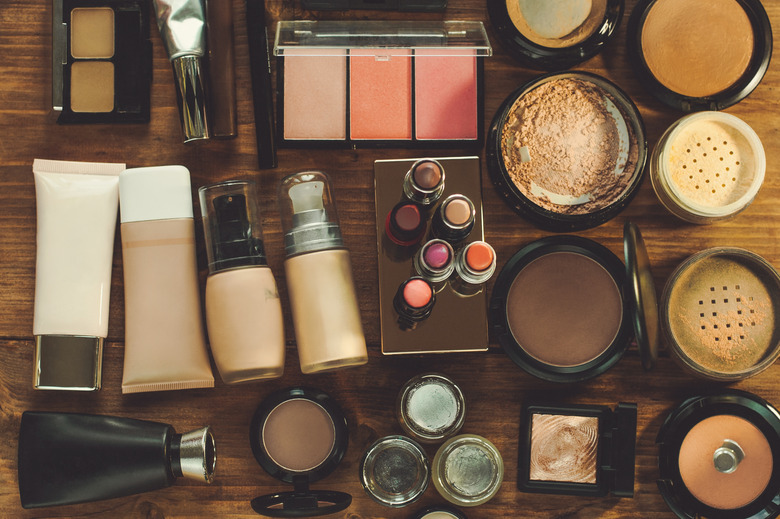Cosmetic Science Fair Project Ideas
The lure of cosmetics such as lipstick, moisturizers, perfumes and bath implements stretches back thousands of years. Ancient civilizations like the Egyptians regularly used lip color, eye makeup and perfumes. The composition of cosmetics changed with the advent of scientific research. Today, the cosmetics industry employs chemists and materials scientists that specialize in perfecting formulas for their appearance, performance, feel and scent. This requires constant testing for safety and improving products. Using scientific experiments, students can work in a similar way with science fair projects to test the efficacy, endurance and appeal of cosmetics purchased at the store and even make their own.
TL;DR (Too Long; Didn't Read)
Students can use store-bought cosmetics or make their own versions to test their effectiveness and perfect formulas. Students can make lipstick and lip balms, test the efficiency of moisturizers or make their own perfume as topics for cosmetic science projects.
Lipstick and Lip Balms
Lipstick
and Lip Balms
Lipstick purchased from a store comes in an endless palette of colors and formations. Some lipsticks tout a glossy texture, while others assure a long-lasting formula. In general, lipsticks still consist of waxes, oils, alcohol and colors. The ingredients in the lipstick determine the quality customers demand.
To test for color differences between lipstick brands, students can use filter paper and swipe a lipstick across it. Then place the filter with the lipstick mark into acetone to demonstrate the array of colors in the lipstick. Complete a separate test for lipstick bleed by gently melting different lipstick smears onto paper strips. Depending on the spread of the lipstick, students can predict which products bleed after lip application. Different lipstick formulations contain different waxes, and students can determine whether or not the melting point of the lipstick's wax is low or high based on its texture and spread.
Making lipsticks and lip balms provides other unique cosmetic science project ideas. A simple experiment to make colorful lipstick involves using children's crayons. By melting crayons of any color in combination with jojoba oil, shea butter and other additions, you can make a variety of different formulations. Students can test how the addition of ingredients such as lanolin, vitamin E or cocoa butter alters the formula. Students can use lipstick containers or other molds to pour their mixture into, and determine which containers work best for different application methods. This also gives insight into materials science and how companies use different molds for cosmetic products.
Testing Efficacy of Moisturizers
Testing
Efficacy of Moisturizers
Moisturizers serve to protect and restore dry skin. This in turn prevents skin infections and injuries due to cracking. Moisturizers also treat skin conditions such as eczema. Moisturizers contain occlusive agents that provide a barrier to keep water in the skin. Some examples include petroleum jelly, mineral oil and waxes. Other agents called emollients smooth skin cracks — many of these are also occlusive agents. A third component, humectants, work to draw water from the secondary layer of skin or the dermis to the outer layer, the epidermis. Humectants include glycerin, honey and alpha hydroxyl acids.
By using gelatin as a substitute for human skin, students can test how well store-bought moisturizers work over time. Students can test ointments, lotions and creams on Petri dishes of solidified gelatin to study the efficacy of the products' occlusive agents, emollients and humectants. After layering each product atop the gelatin, students record observations at several time points over two weeks. Differences in height and weight of the gelatin in the Petri dish determine any evaporation or cracking of the gelatin. In addition to the gelatin model for skin, students can provide volunteers with samples of the same moisturizers and ask them to use them for the same period, then record volunteers' opinions and skin appearance.
Make a New Perfume Fragrance
Make a New Perfume Fragrance
Another ancient cosmetic item, perfumes endure after millennia. While many perfumes today contain synthetic chemical ingredients, flowers and leaves and even musk from animals still comprise the ingredients of these wearable scents. Perfume-making methods include distillation, expression, maceration and enfleurage. Students can use enfleurage to scent vegetable shortening. Press petals from desired flowers into the shortening, and use ethyl alcohol to extract the scent. Students record the variation in scent over a few days, depending on whether they replaced petals daily and how long the petals remained in the shortening. After testing the scent of the shortening each day, on the final day, students must melt the shortening and combine it with alcohol to release the scent. Students then test the scent of each sample and record any variations.
In all these potential cosmetic science projects, students gain insight into observation, measurement, materials and variations needed for the scientific method.
References
Cite This Article
MLA
Hermance, Dianne. "Cosmetic Science Fair Project Ideas" sciencing.com, https://www.sciencing.com/cosmetic-science-fair-project-ideas-5818019/. 23 April 2018.
APA
Hermance, Dianne. (2018, April 23). Cosmetic Science Fair Project Ideas. sciencing.com. Retrieved from https://www.sciencing.com/cosmetic-science-fair-project-ideas-5818019/
Chicago
Hermance, Dianne. Cosmetic Science Fair Project Ideas last modified August 30, 2022. https://www.sciencing.com/cosmetic-science-fair-project-ideas-5818019/
